In the Moment:
Michael Frye's Landscape Photography Blog
by Michael Frye | Jun 26, 2015 | Digital Darkroom
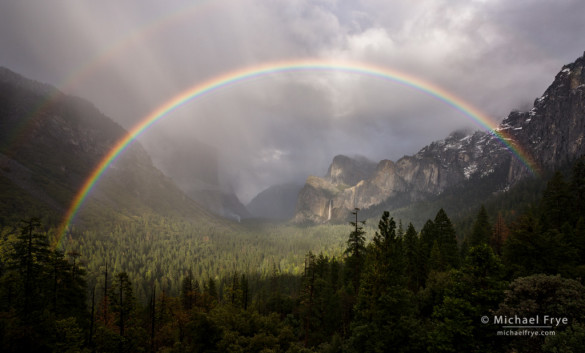
Rainbow over Yosemite Valley from Tunnel View – after applying the Dehaze control
Last week Adobe added an update to Lightroom CC, designated the 2015.1 release. It includes a couple of new features. The main one is a Dehaze slider, designed to reduce the appearance of atmospheric haze. It’s found in the Effects Panel of the Develop Module.
I’m usually skeptical of things like this. Is it really different than adding Contrast or Clarity? Well, yes, actually. Adobe says, “The Dehaze technology is based on a physical model of how light is transmitted, and it tries to estimate light that is lost due to absorption and scattering through the atmosphere.” I’m not sure how they do that exactly, but it seems to work more effectively than just adding Contrast or Clarity.
(more…)
by Michael Frye | Jun 21, 2015 | Travels and Stories
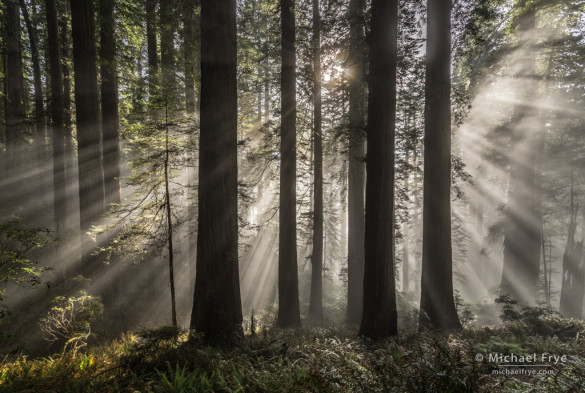
Sunbeams in a redwood forest, northern California coast
Today is the solstice, the official start of summer. It’s felt like summer for weeks here in the Sierra foothills. It’s been hot, and dry. Four (!) fires broke out near Mariposa and Oakhurst Thursday; fortunately they were all subdued quickly.
(more…)
by Michael Frye | Jun 17, 2015 | Announcements
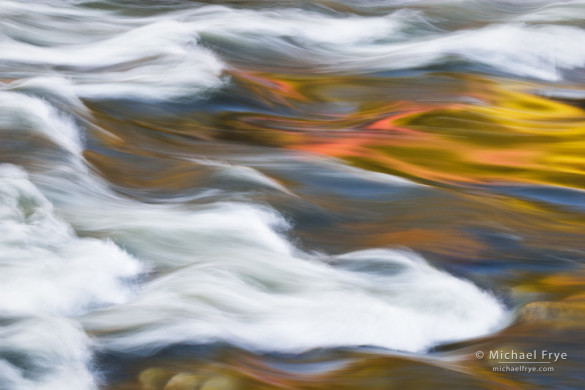
Redbud reflection in the Merced River (part of the portfolio)
I’m honored to have a portfolio of my images, plus an in-depth interview, included in the latest issue of Photograph digital magazine from Craft & Vision. Regular readers have probably seen most of the images in the portfolio before, but it’s nice to view them all together, and I thought the questions the interviewer asked were interesting and thought-provoking.
There are three other portfolios in this issue – a fascinating and diverse collection. I enjoy looking at different kinds of photography, and especially liked Jordan Manley’s portfolio, as it blends elements of sports, photo-journalism, and landscape in an artful way.
(more…)
by Michael Frye | Jun 14, 2015 | Light and Weather
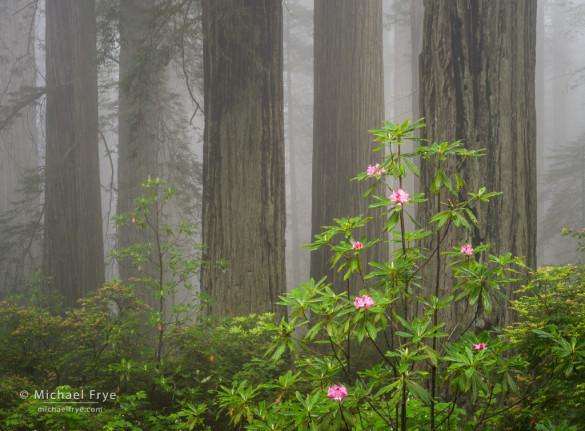
Redwoods and rhododendrons along the northern California coast
As promised, here are some more images from our time up in the redwoods. I just love this area, with all its damp, primeval moodiness. Claudia and I were there for almost two weeks, and experienced a great variety of weather, including fog, overcast, sun, clouds, and some colorful sunsets. And on the last day of the workshop we went to a beach near Trinidad during a minus tide, where we found some beautiful pools and reflections, and easy access to starfish and other tide-pool creatures.
The variable weather required flexibility. Anyone who’s taken a workshop with me knows that I rarely tell the group very far in advance where we’ll be going. I’d rather wait until the last minute to assess the weather, then go where conditions seem most promising.
(more…)
by Michael Frye | Jun 12, 2015 | Light and Weather, Travels and Stories
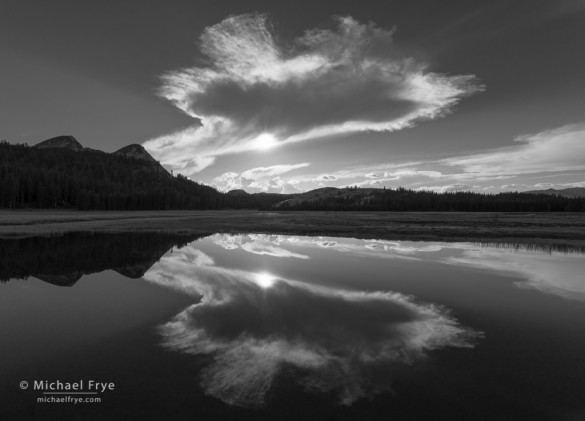
Cloud formation reflected in a pond, Tuolumne Meadows, Yosemite NP, CA, USA
Claudia and I did head up to the high country yesterday afternoon, and found some great clouds. We drove through a nice downpour near Crane Flat, then continued up to Tuolumne Meadows, where I photographed a beautifully-shaped cloud reflected in one of the ponds (above). Later a storm cell formed over the peaks to the east, creating another dramatic cloud formation (below). That cell gradually dissipated, but some clouds still lingered until sunset (the last photo below). It was a really fun afternoon – I’m glad I finally made it up there!
(more…)
by Michael Frye | Jun 11, 2015 | Light and Weather, Photography Tips
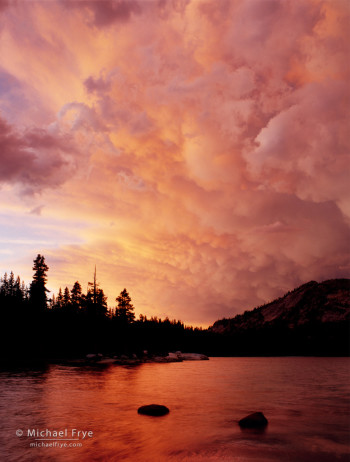
Sunset clouds over Tenaya Lake, Yosemite NP, CA, USA
I haven’t had many opportunities to get into the Yosemite high country since Tioga Pass opened, but I hope to head up there soon – maybe even this afternoon, since it looks like some clouds are building. Clouds and thunderstorms always make the summer days in the high country interesting, and potentially photogenic.
This photograph, from July of 2003, shows one of the most spectacular cloud formations I’ve ever seen. Claudia and I were in Tuolumne Meadows, and watched and photographed a thunderstorm move through from east to west. I hoped that after the storm passed we’d see some interesting light, but no such luck – it was just overcast. So I decided to follow the storm, and drove west toward Tenaya Lake.
We stopped near the eastern end of the lake. I got out of the car and looked out to the west, but the scene didn’t look very interesting in that direction. Then I looked over my shoulder. Holy crap! I saw this turbulent line of clouds, lit by the setting sun, and knew immediately that I was in the wrong spot – I needed to be on the other side of the lake.
(more…)
by Michael Frye | Jun 7, 2015 | Light and Weather, Workshops
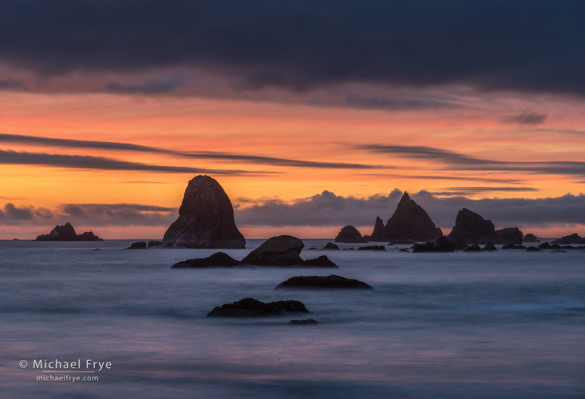
Sea stacks at sunset , Redwood NP, CA, USA
We had a wonderful time last week during our redwoods workshop. It was a really nice, fun group, with great camaraderie and lots of laughter, aided and abetted by the relaxed atmosphere at the fabulous Requa Inn. We got some fog, which is always a great complement to the forest scenes, and were also treated to a couple of beautiful sunsets along the coast.
(more…)
by Michael Frye | May 31, 2015 | Reviews
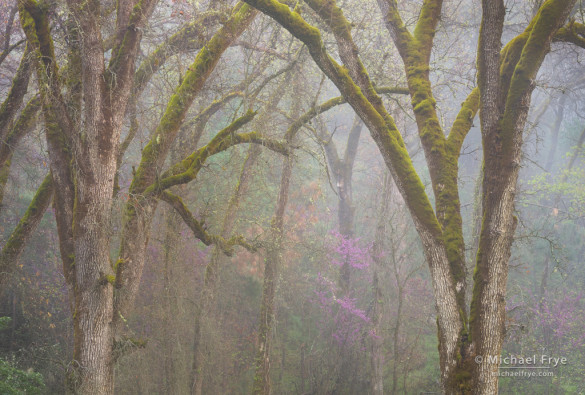
Oaks and redbuds in the fog, Mariposa County. A sharp lens, good technique, and the 36-megapixel sensor on my Sony A7r captured an incredible amount of detail in this photograph; I’ve printed it up to 40×60 inches with great results.
I’ve been getting a lot of questions lately about Canon’s new 50-megapixel cameras, the 5DS and 5DS R. These models haven’t been released yet, but many Canon users are wondering whether they should upgrade.
Since these cameras aren’t available for testing yet, it’s hard to say anything definitive about them. But since I bought my 36-megapixel Sony A7r over a year ago I’ve learned a lot about working with high-resolution cameras, and some of those lessons might be relevant to people who are considering buying one of those new Canon models, or a 36-megapixel camera like the A7r, Nikon D800, or Nikon D810.
(more…)
by Michael Frye | May 30, 2015 | Light and Weather, Travels and Stories
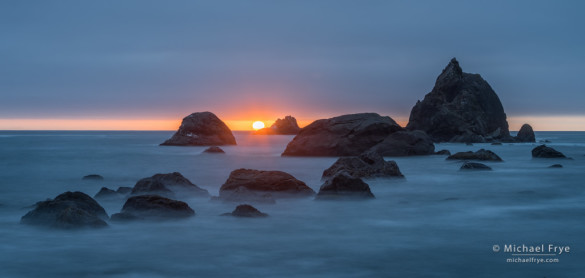
Sea stacks at sunset along the northern California coast, Redwood National Park
Claudia and I are back in the redwoods, scouting and preparing for our workshop next week. I feel such a deep connection to this damp, lush, wild, primeval landscape. It feels like coming home.
While it’s common to find fog or low stratus here, over the past couple of days the stratus deck has been unusually persistent, staying all day instead of burning off in the afternoon. This is great for photographing redwoods, where fog often adds the perfect complement to the forest scenes. It doesn’t work so well for coastal landscapes, where sunlight usually helps. But we did see the sun poke underneath the stratus at the last moment one evening, as you can see from the photograph above. And I’ve included a few forest photographs below. I’m really looking forward to the workshop!
— Michael Frye
(more…)
by Michael Frye | May 24, 2015 | Yosemite Photo Conditions
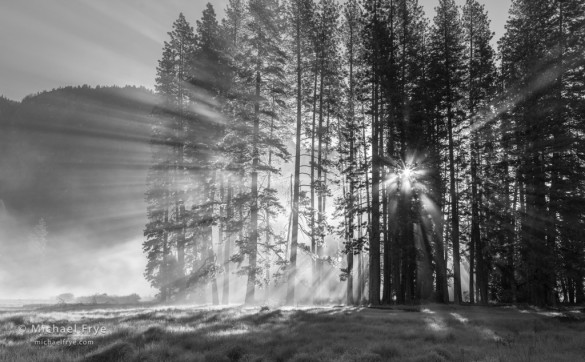
Pines, sunbeams, and mist, Cook’s Meadow, 6:13 a.m.
Yosemite got some rain yesterday. In fact we’ve had a lot of unsettled weather this month, with frequent showers in the afternoon, especially in the high country. Tioga Pass opened May 4th, but has since closed and reopened several times due to snow. The total precipitation hasn’t amounted to much, but every bit helps, and we’ve even had enough rain here in the foothills to keep the grass from turning brown – at least in some places.
I haven’t had much time to get up to the park and photograph the weather, but after the rain yesterday it seemed likely that there would be mist in the meadows this morning, so Claudia and I rose early and drove up to Yosemite Valley. When I say early, I mean really early. Sunrise is at 5:40 a.m. these days, which meant leaving home at 4:30!
(more…)


















